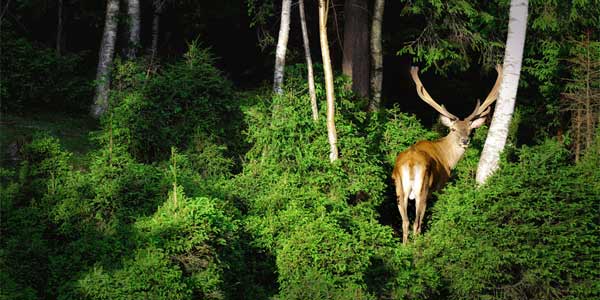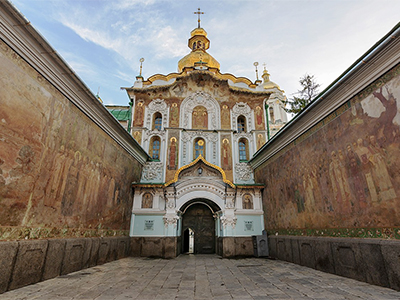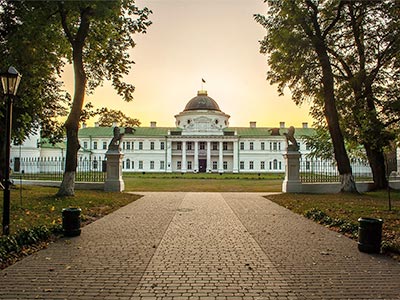 06.08.2013
Carpathian National Natural Park
06.08.2013
Carpathian National Natural ParkCarpathian National Natural Park (CNNP, www.cnnp.yaremcha.com.ua) was established by the resolution of the Council of Ministers as of June 3, 1980.
Its mission is to preserve the natural complexes typical of Chornohora and Gorgany, as well as to conduct scientific research in environmental protection, to create conditions for recreation and health improvement to promote environmental knowledge and ecological education.
Area
The total area of the park is 50 495 ha. If is situated in the Northeastern part of the Ukrainian Carpathians and occupies the territory at altitudes of 500-2061 m above sea level. The park extension from north to south is 50 km, its width is 20 km. The territory of the park is divided into three geomorphological regions: ridge Chornohora, Vorokhta low-hill terrain and subdued Gorgany.
Forests
Forests of The Nature Reserve Fund of Carpathian Park are divided into twelve environmental Research Departments (ERD), two of which are protected. As with all mountainous regions one can easily trace altitudinal zonality: upper and lower mountain forest zones, as well as subalpine and alpine belts.
There is dense hydrographic network on the park territory. The Prut River is the main waterway. Its length on the park territory is 50 km. It forms numerous rapids and waterfalls in those places where it rises above the surface.
The park is divided into zones: Protected (1.4 thousand ha), Controlled Recreation (25.9 thousand ha), Permanent Recreation (96.2 ha) and Commercial (13 thousand ha).
Mission
Carpathian NNP plays a crucial role in preserving natural and cultural values of the Carpathian region. 600 ha of Spruce and Beech primeval forests are protected here. Within the park there are more than 1100 species of higher vascular plants, among them 70 wood species, and 110 shrub species. The prevailing forest-forming species are Fir spruce, European Pine, European Beech, 95 species are included in the Red Book of Ukraine, in particular: Common Snowdrop, East Carpathian Edelweiss, Crocus Heuffelianus, Alpine Aster etc. Among flora representatives there are relics and endemics (around 60 species) on the territory of the park. These are Rhododendron Myrtifolium, Carpathian Soldanella. Carpathian Bellflower, Northern Twin-flower etc. Four species of plants are included in the European Red List.
Fauna
Fauna on the territory of the park includes 192 species of vertebrata and 723 species of invertebrata, among which there are 53 species of mammals, 19 of which are included in the Red Book of Ukraine. The Carpathians are famous for Red Deer, European Roe Deer and Wild Boar. As for predators there is Brown Bear, Wolf, Fox, Lynx, Marten and Ferret. There are 120 species of birds, 24 of which are included in the Red Book of Ukraine. Among bird fauna of the park there is Capercaillie, Black Grouse, Golden Eagle, Lesser Spotted Eagle, Owl, Long-Tailed Owl. Reptiles are represented by 6 species. Among them are Adder, Grass Snake, Slow Worm, Sand Lizard and Common Lizard. Amphibia are represented by 12 species. Triturus Montandoni, Triturus Alpestris, Spotted Salamander and Yellow- bellied Toad are included in Red Book of Ukraine. In rivers there are Bull Trout, Char. Nase, Barbell etc. Among a large number of Entomofauna, 17 species of insects, which are included in the Red Book of Ukraine, are registered in Carpathian NNP (Stag Beetle, Alpine Rosalia, European Swallowtail, Purple Emperor etc.).
Recreation zones
On the park territory there are footpaths (scientific and educational, ecological and educational, tourist), outdoor enclosures (Wild Boars and Deer are kept there), zones and places for recreation.
For tourists there is an Eco-Tourist Visit-Centre. Also there are bee-farming and objects of the Polonyna kind. For unorganized recreation there are 10 recreation zones and 10 leisure areas which are situated near traffic roads.
Scientific research
At the Research Nursery-Garden, “Pidlisniv” research is conducted on the introduction and acclimatization of valuable ornamental plants, selection work on breeding persistent root forest forming species, phenological and ecological and morphological research of Carpathian flora representatives.
A wide range of coniferous and foliage species of wood are grown here for the purpose of landscaping (ornamental and fruit trees).
Carpathian NNP is a kind of an open-air museum of nature, a unique gallery of scenic beauty, therefore it welcomes all visitors. In order for others to enjoy the beauty, it is necessary to keep It all Intact for those who will visit this place after you.
More than 35 Million years ago, the present territory of the Carpathians consisted of the ocean called Tetis. The layers of sand, clay and limestone under the ocean hardened with time and in result of mountain-forming processes rose from the bottom of the water onto the surface. So the mountains were created with soft forms of their relief and wonderful nature.
“Where there are mountains and highlands…”
In 1980 in the very heart of the Ukrainian Carpathians, in their southeastern part (Chorna Hora and Horhany) the Carpathian National Natural Park (= CNNP) was created. On its territory, that occupies more than 50.000 hectars, lies the highest mountain of Ukraine – mount Goverla (2062 meters above sea level) and at her foot begins the main artery of the CNNP – the river Prut, which on its way collects water from numerous streams with exotic names like Zhenets, Zhonka, Kamyanka and others.
Rivers
The bottom of the Prut is uneven, stony and the flow is rapid. There are many waterfalls and thresholds. Picturesque is the waterfall Probiy (hasp) in Yaremche. Its height until in 190 was 20 meters. In order to improve the transporting of tree-logs it was dynamited and is now 8 meter high. A left tributary of the Prut, which begins on the slopes of Goverla, forms the longest in Ukraine cascade of waterfalls. It is called Huk and has a height of 84 meters. The roars of the waterfalls can be well heard in the whole surrounding area. The name Huk comes from the roar.
On the territory of the park there are two lakes: lake Nesamovyte (furious) and lake Maricheyka. Both are woven with legends from pagan times.
Forests
The basic wealth of the national park are the forests. Beech, common spruce and silver junipers form the main stock. Here grow over 1100 arts of plants, 70 arts of trees and 110 bushes. More than 80 arts of plants are entered into the Red book of Ukraine. Among them the european ceder pine tree, four (yellow, speckled, separate and spring) sorts of gentians, the pink rodiola and the arnica plant. History of forest alloy in Carpathians.
Animals
The variety of the landscape determines the variety of the animal world.The main hoofed animals are the noble deer, the european roe and the wild pig. As predators, one can meet brown beers, wolves, lynxes, martens and polecats. Typical ornithological representatives are the wood grouse, black grouse, hazel-hen, toy pistol and woodpecker. Altogether 114 birds are accounted for. Among reptiles, one can come upon vipers, grass-snakes, and lizards. The spotted salamander and three types of tritons are entered in the Red Book. In the rivers and lakes there are 12 types of amphibious, especially the trout, loach and madder. Hunting and fishing traditions of Carpathians. If you’re a fishing fan, you must to know about fishing in the Carpathians.
Nature inspires
The territory of the Carpathian National Natural Park is part of the historical-ethnographical region, which is populated by an autochthon people called Hutsuls. These are talented and inventive people, which nature inspires to be creative. The region is known for carvers, weavers, carpet-weavers, embroiderers. The Hutsuls have conserved their differences in language, clothing, culture, way of life, folk habits and traditions and such already attract attention to themselves. Many monuments of history and culture, which are on the territory of the national park, are under state protection. An exclusive uniqueness display wooden churches, which were built in forms of a Hutsul regional school.
Recreation
Thanks to favorable climatic conditions and picturesque natural and landscapes, the Carpathian National Natural Park enjoys a large popularity among tourists. The development of all types of recreation demonstrates to huge number of tourist and sport complexes, sanatoriums and centre for preventive medicine, health care centers and private farms that accept guests.
The most favorable period for recreation and medical treatment is the summer and autumn season – between the months of May and October. Tourists are offered a net of ecologically and turistically relevant paths and tourist routes with a general duration of 300 kilometers. Among them “Path of Dovbush”, “To Mount Goverla” and “To Mount Khomyak”.
On the territory of the national park there are 10 places of rest and 12 zones of recreation, that are mainly situated near the transport routes. Attractive for tourists are the zones of recreation “Vorotytshe”, “Barvytsche” (village Mykulychyn), “Tramplin” (village Vorokhta) and the wild animal farm in Yaremche with segregated sections for noble deer, roes and wild pigs.
When travelling through the Carpathians please do not forget to adhere to the rules of good conduct on the territory of national park. Do not damage live and lifeless nature, do not light fires in places not reserved for such purpose and do not leave litter. Remember about those who will come after you.
-
 27.02.2024
World of pysanka
Embark on a journey into the captivating world of Pysanka, the Ukrainian...
27.02.2024
World of pysanka
Embark on a journey into the captivating world of Pysanka, the Ukrainian...
-
 29.01.2024
Exploring the Treasures of Kyiv’s Lavra Monastery
In the heart of Kyiv lies the venerable Lavra Monastery, a testament...
29.01.2024
Exploring the Treasures of Kyiv’s Lavra Monastery
In the heart of Kyiv lies the venerable Lavra Monastery, a testament...
-
 13.01.2024
Kachanivka, Eden on Earth
Rich in history, it hosted renowned artists, notably poet Taras Shevchenko.
13.01.2024
Kachanivka, Eden on Earth
Rich in history, it hosted renowned artists, notably poet Taras Shevchenko.

